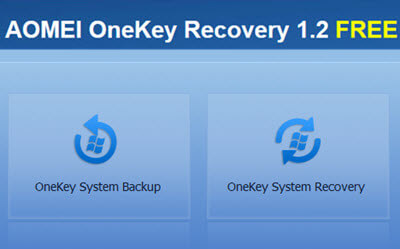Most regular DCT readers will be well aware of the importance we place on creating backups, and especially full system backups. The ability to restore a system to a previous healthy state can overcome just about every major issue encountered by users, including terminally corrupt or infected systems.
Creating a Recovery Partition to Protect Your System
These days, most computers come with some kind of ‘restore to factory settings’ partition included but, while these can certainly be a blessing, they also generally require a lot of re-installing favorite programs and masses of Windows updates in order to bring the system back to its original usable state. Plus, of course, getting rid of all the manufacturer’s pre-installed crapware and trialware all over again.
Aomei OneKey Recovery helps overcome this time consuming chore by providing a method to create a system recovery partition at any given time of your own choosing. For example: You purchase a new computer, uninstall all unwanted crapware and trialware, install and setup all your favorite programs, adjust your settings and preferences to suit, apply outstanding Windows updates, THEN create a system recovery partition using Aomei OneKey Recovery. This system recovery partition can then easily be updated at any time by simply going through the creation process again.
The recovery partition can be created on the system disk, second internal hard drive, external hard drive, or USB flash drive – on the proviso that there is sufficient space of course.
Initiating recovery is simply a matter of pressing either the “A” or “F11” keys on MBR system disks or selecting “Aomei OneKey Recovery” from the boot menu on GPT (EFI/UEFI boot) system disks.
- View a full guide on creation and recovery here: How to Make a Factory Recovery Partition to Protect Windows System
The obvious question here is how does this differ from creating full system images using something like Aomei Backupper? The answer is, essentially there is little difference. However, while system imaging software offers a wider range of options and flexibility, the Aomei OneKey Recovery method provides utter simplicity, especially for less experienced users.
I suspect most advanced users would tend to prefer a reliable imaging software but even something as simple as Aomei Backupper can often be challenging for inexperienced users and Aomei OneKey Recovery provides those users with a simpler method for restoring a recalcitrant system back to working condition.
Personally, I think it’s a great idea and, to those users who’ve tried traditional imaging tools and found the process a bit tricky, I’d highly recommend you check out Aomei OneKey Recovery.


Many thanks, Jim for your continued support and hints on this stuff!
It’s very valuable info. and even better knowing it has been checked over by someone with obvious knowledge of the “art”.
Much appreciated.